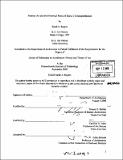Postwar art and historical roots of Beirut's cosmopolitanism
Author(s)
Rogers, Sarah A. (Sarah Anne)
DownloadFull printable version (139.1Mb)
Other Contributors
Massachusetts Institute of Technology. Dept. of Architecture.
Advisor
Nasser O. Rabbat and Caroline A. Jones.
Terms of use
Metadata
Show full item recordAbstract
This dissertation charts the production of Lebanese cosmopolitanism from the nineteenth century to the present, examining how this putatively national trait is established through the visual arts. It contends that in order to understand the strategies of a group of artists who have come to represent artistic production in the aftermath of the Lebanese civil war (1975-1990), we must consider the historical formation and failures of Lebanese cosmopolitanism as a national myth. The end of the civil war coincided with a period of celebratory globalism in the art market, and in the following decade postwar artists from Beirut garnered the attention of the western art world. Exhibition catalogues and critical reviews alike characterized this body of work as emerging out a tabula rasa for the visual arts: no audience, no institutions, and no markets. This dissertation argues instead that the postwar generation did not develop out of a historical eclipse created by the civil war, but is part of the much longer history of Lebanese cosmopolitanism. By resituating the postwar generation within this history, we can understand the mechanisms by which the western art world fabricates a mythology of a local art. Tracking Beirut's transition from under the Ottoman Empire and French Mandate to an independent capital besieged by civil war through to the postwar period, I identify those moments when the project of defining Lebanese art comes to the forefront. (cont.) Integrating an analysis of art works, archival material, institutional histories, and art historical narratives this dissertation suggests that the relationships between the terms cosmopolitan, national, and art are socially constituted and discursively produced. Rather than the innate outgrowth of the independent nation state of Lebanon, cosmopolitanism in this context is revealed as an ideological tools used to entrench internal ethnic boundaries, referencing a particular correlation between Lebanon and Europe, and constructing a national vision historically tied to the Maronite Church of Mount Lebanon. Contextualizing the postwar generation within this longer history allows for an understanding of the broader processes by which history is either made present or obscured in the intersecting imaginative geographies mapped into Lebanon.
Description
Thesis (Ph. D.)--Massachusetts Institute of Technology, Dept. of Architecture, 2008. Includes bibliographical references (v. 2, leaves 304-316).
Date issued
2008Department
Massachusetts Institute of Technology. Department of ArchitecturePublisher
Massachusetts Institute of Technology
Keywords
Architecture.